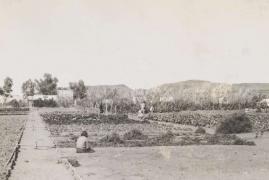The difficulties faced by missionaries at Hermannsburg are to some extent self-evident. They were living in isolation from extended family and friends and modern conveniences. In many cases they arrived straight from cooler European climates and were totally unprepared for the heat and the drought. Support and resources from down south fluctuated along with church finances and commitment and there must have been many times when the missionaries felt despair and exhaustion.
Some accounts may suggest that for Aboriginal residents the arrival of the missionaries brought comfort and improved lifestyles and removed the struggle faced by hunter-gather economies, however this would be an incomplete picture of the hardships that most mission residents endured in their daily life. Food was often scarce and mission resources stretched. Albrecht recalls that at one stage the mission could barely afford to feed its Aboriginal residents:
“…only a flour soup three times a day, made up of one pannikan of flour for 10 people…” (F.W. Albrecht in Leske (ed)2016:44).
Clearly nutrition was likely to be poorer than that available from a traditional lifestyle and yet increasingly education at the mission led people away from their traditional way of life and they developed a taste for refined flour, sugar and jam and relied less and less on bush foods.
Growing enough food
Producing enough food crops was an ongoing challenge at Hermannsburg due to the unreliable water source. Living on the mission meant that people were centred in one area putting pressure on limited water resources. During the drought of 1927-1929 the lack of water and the reliance on mission food combined with deadly consequences. People developed scurvy and 85% of all Aboriginal children died. Adults were affected too and at one point the mission records 17 funerals in one month.
At the end of 1929 the rains brought a welcome relief to the drought but many adults who had been weakened by the prolonged illness now developed tuberculosis.
Media







